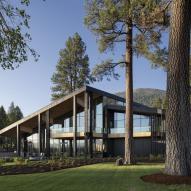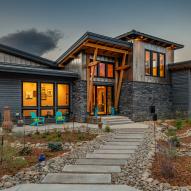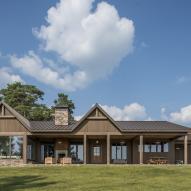Blending In With Shou Sugi Ban
“I always welcome natural wood,” says architect Patrick Flynn. “If I know that a client wants my input and suggestions, I’m always going to include wood as an option.”
So, when it came time for Flynn to side this New York residential product, it was wood that he chose from. Wood siding with a unique charred finish called Shou Sugi Ban.

“A builder told me about Shou Sugi Ban and Pioneer Millworks,” says Flynn. “The Shou Sugi Ban as a finish, I just love the idea of it—how the Japanese method brings out the grain and the character. There are so many different options for the burning technique. What shows and what doesn’t, in terms of the grain and color. The look also depends on the species of the wood, and in the case of this Seneca Lake home it’s the larch.”
“We used Pioneer Millworks sustainably sourced PEFC (Programme for the Endorsement of Forest Certification) Larch Shou Sugi Ban for the entire house besides the trim on the exterior,” says Derek Duell of Pennwood Development LLC, the builder on the project. “We also used it for a few accent walls inside the house.”
How our Shou Sugi Ban is made, also affects the finish result. After burning the surface layer of our PEFC sourced Larch, we then wire-brush each plank to remove the soft char and expose the inherent grains below. Because larch is a durable wood exterior option with attractive tones, interesting grain patterns, as well as being rot, insect and fire-resistant. It’s the perfect choice for a biophilic focused home like the “Seneca Lake Perch”.

The Seneca Lake home is nestled on a lofty cliff high above Seneca Lake’s waters and is entirely cladded with Pioneer Millworks Shou Sugi Ban Larch Toasted siding. A beautifully rich vibe, the Shou Sugi Ban Larch Toasted emits a warm golden brown naturally accented with notes of dark char. On the outside of the house, it expresses an aesthetic that is all at once both original and familiar and rustic and contemporary. Luxuriously textured and visually detailed, the Shou Sugi Ban can be left unfinished to patina naturally, or it can be coated with an exterior grade finish.
“It came with the initial sealer, but I’m not sure if the homeowner is going to keep up with that or let it age the way it is,” says Flynn. “The homeowner wanted low maintenance, so it could have something like a composite. Once they saw the Shou Sugi Ban and understood that if they seal it, original finish will last, it became ‘low maintenance’. Even if the homeowners decide not to keep up with the preservative it going to age well.”

“I always leave the final siding choice up to the client and their budget, but I would like to use Shou Sugi Ban again,” says Duell. “It went together nicely.”
“I think it’s an excellent choice for blending a home into the surrounding environment and making the house look like it belongs naturally in the woods,” continued Duell. “Technically, it’s equivalent to working with other claddings or composite woods, it just looks so much nicer.”
The collaboration of Shou Sugi Ban with the surrounding palette of the property makes the house a piece of living art. It postures stoically in contrast to the deep blue of Seneca Lake and plays beautifully next to the natural woodland hues of its surroundings.
“It’s the natural wood material, how its harvested, used, in addition to its aesthetic for me it’s a big plus why I like it,” says Flynn.
Architect: Patrick Flynn
Builder- Pennwood Development, LLC
Material Design - In/Out-Toni Vecchitto of Vero Designare
Cabinetry - Smith Valley Woodworks
Exterior Siding and Interior Flooring – Pioneer Millworks





